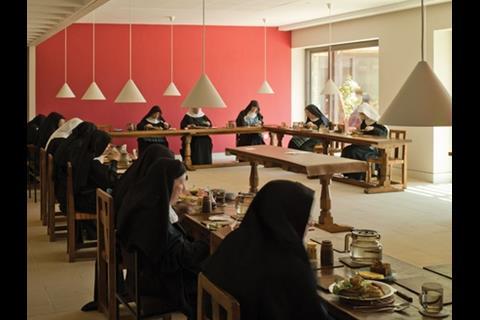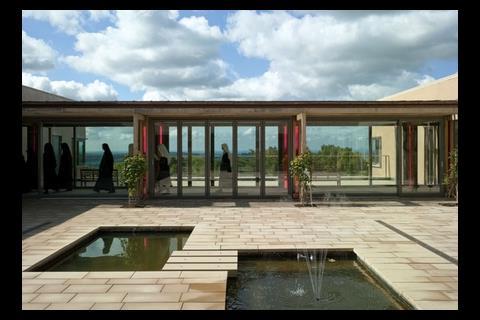Nuns may not be the most demanding of clients, but apparently they do expect a building to be ‚Äėtranscendental‚Äô. Dan Stewart took a pilgrimage to Feilden Clegg Bradley‚Äôs Stanbrook Abbey in the Yorkshire moors to find out what that means
‚ÄėNot what you were expecting, is it?‚ÄĚ says the taxi driver, as Feilden Clegg Bradley‚Äôs home for the nuns of Stanbrook Abbey hoves into view. In truth, it is hard to know what to expect a new monastery to look like, particularly when your imagination is distracted by visions of the great Cistercian abbeys once stood over the North Yorkshire countryside.
The dramatic location is perhaps all that this building shares with its medieval forebears (it is difficult to imagine anyone but those in mystical communion with either God or the local authority being able to build on a hill in this landscape). Unlike Rievaulx, Jervaulx and Fountains, this abbey is a smaller, calmer and rational proposition, albeit one that the nuns should still find worthy of praise.
The Benedictine sisters of Stanbrook Abbey have moved to Yorkshire from Worcester, where they lived in a 19th-century grade I-listed mansion and worshipped in a church designed by Augustus Pugin. As the order was now only 30 strong, compared with more than a hundred at its peak, the building had become too large and expensive for them to maintain. Having looked at sites around the country, the nuns settled on this large patch of land in Yorkshire to build a more humble residence.
Although planners seldom allow building of any sort to take place in the North Yorkshire Moors Park, they made an exception for Stanbrook. ‚ÄúThey were chuffed to have an order of nuns coming back. Yorkshire has a monastic tradition, and it was very attractive to them,‚ÄĚ says Gill Smith, Feilden Clegg Bradley‚Äôs project architect. ‚ÄúThey used something called an ‚Äėextraordinary building for extraordinary people‚Äô clause. Well, they are certainly extraordinary people, and we can only hope it‚Äôs an extraordinary building too.‚ÄĚ
If anything, we were more conservative than the nuns were. We got the impression they would be amenable to something amorphous, or blobby
Gill Smith, Feilden Clegg Bradley
Feilden Clegg Bradley had its work cut out. Monastery design isn‚Äôt a regular module on architecture courses these days, and the nuns‚Äô brief called for a building that was ‚Äútranscendental‚ÄĚ. Where do you start? The 2008 Stirling prize-winner did what any good architect does and visited monasteries around the country, from Worth Abbey in Sussex, to Downside in Somerset and Buckfast in Devon.
Although this gave the team a good idea of the requirements of the building, the question of style was still unresolved. Although Smith says the nuns would have been happy with something unorthodox, they stuck to a more traditional look. ‚ÄúIf anything, we were more conservative than they were. We got the impression they would have been amenable to something amorphous, or blobby.‚ÄĚ Feilden Clegg Bradley‚Äôs thinking was led, Smith admits, by their perceptions of what is ‚Äúreligious‚ÄĚ. ‚ÄúIf you‚Äôre not religious, you need religious stuff to make it religious: stone, arches, colonnades, cloisters, they spell religion to us. But not to them!‚ÄĚ
The decision was made to design a building that would reflect the order, tranquility and simplicity of the nuns‚Äô lives and routines. The ¬£4.2m building is laid out orthogonally, with the public areas ‚Äď a church, guest rooms and gift shop ‚Äď on the eastern side, to which visitors approach. The bulk of the nuns‚Äô communal spaces, which include a refectory, kitchens, laundry, sewing rooms and sick bay, are based over two storeys around a central cloister. The nuns‚Äô cells are laid out in a row from beneath the main building out to the end of a long wing at the south-west corner. Each has an unbroken view across the hills. Behind this wing will eventually be a library, but for now the only completed element is the first phase: the nuns‚Äô cells and living areas.
In style, the completed first phase of the building is reminiscent of Feilden Clegg Bradley’s houses at the Accordia development in Cambridge, with the free-standing chimneys of that scheme replicated in the bell-tower and biomass flue. The material palette is also similar: the cladding is mainly light grey offcuts of paving stones. When the building is completed, much of the remaining ochre render will be covered by the same oak that makes up the structure of the balconies and balustrades. The detailing and landscaping is not as elegant as Accordia, having less than a 10th of its budget, but it shares something of Accordia’s orderliness.
There’s nowhere to put our books and folders yet. It’s not ideal, but as long as I have my cell I am happy
Stanbrook Abbey nun
Symmetry and clean lines abound, from the spartan corridors of the cloister to the long row of cells, and natural light has been used ingeniously throughout, in the form of light wells and hidden windows. Landscape architect Camlin Londsdale has created a gentle, Italianate garden and pools in the centre of the cloister which, despite its picturesque quality, give a touch of artifice to a building that has otherwise thrown it off completely.
The form of the convent is perhaps most reminiscent of a hotel or a retirement home ‚Äď with obvious differences. For one, there is a lack of showiness in the detailing and decor that distinguishes it from somewhere you would pay to sleep. The timber is untreated, the lighting undecorative and the colour scheme is mostly neutral beiges and greens.
It is also unlike a retirement home in that there are few signs of belongings or furniture. Nuns reject the material clutter of ordinary life ‚Äď ‚Äúthey don‚Äôt tend to spend loads of money on shoes,‚ÄĚ says Smith, drily ‚Äď and in fact they have sold much of their old furniture and possessions to help pay for the building, raising ¬£90,000.
Sadly, the money needed to pay for the next phases of Stanbrook is still up in the air. The nuns need to sell the Worcestershire building before they can fund the construction of a library, guest rooms and ‚Äď most importantly ‚Äď chapel. ‚ÄúIt is like a body without a head,‚ÄĚ Smith says of the incomplete building. The nuns are using a meeting room as an improvised chapel, but as they spend up to eight hours a day in prayer, it is hardly sufficient for their needs. ‚ÄúThere‚Äôs nowhere to put our books and folders,‚ÄĚ says one when I ask how they are coping. ‚ÄúIt‚Äôs not ideal, but as long as I have my cell I‚Äôm happy.‚ÄĚ
Until it is completed, it is difficult to determine whether or not the building is transcendental. But it is to Feilden Clegg Bradley‚Äôs credit that they have kept their ambitions grounded, and focused on the humanism and humility of the sisters‚Äô lives. It is the absence of that religious ‚Äústuff‚ÄĚ, as Smith calls it, that accounts for the success of the building. Instead, there is a sense of calm that would soothe the soul of even the most irreligious reviewer.
The hills are alive: ļŕ∂ī…Á«Ý in a national park
The building‚Äôs sensitive location was a strong factor in the choice of materials and servicing strategy. ‚ÄúThe nuns wanted to fit as harmoniously as possible into the National Park,‚ÄĚ says Louise Wray, project architect at Feilden Clegg Bradley. ‚ÄúThey wanted to have as little impact on the landscape as possible.‚ÄĚ A second factor was that the nuns wanted a building that was easily maintained ,as many of them are elderly.
The building has conventional cavity walls with the outer masonry leaf constructed from a Yorkshire sandstone sourced from 50 miles away. This was a byproduct of paving stone production. Oak has been used for elements such as the cloister link and solar shading.
The building is heated using a woodchip boiler fired using locally sourced chips. Solar panels heat the water in the summer and a gas boiler provides backup. Because the building is in the middle of nowhere, there is no connection to the sewage system. The low impact solution is a reed bed treatment system. Effluent goes into a septic tank, and once this has been broken down it is pumped into a reed bed that further cleans it before it is allowed to percolate into the ground.
Water from rainwater harvesting is used for laundry and flushing toilets and as the building has more roof collection capacity than the nuns need this only requires topping up with mains water when conditions are very dry. Green roofs help control water run-off and also look attractive when viewed from high level rooms.
Project team
Client Conventus of our Lady of Consolation
Architect Feilden Clegg Bradley Studios
Project manager and QS Davis Langdon
Structural engineer Structures One
Services engineer Aecom
Landscape designer Camlin Lonsdale
Main contractor William Birch & Sons
Downloads
Plan
Other, Size 0 kb

































No comments yet